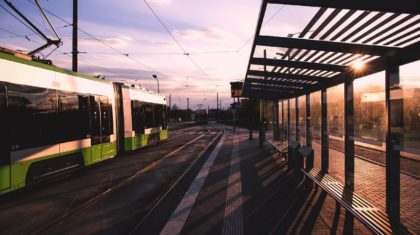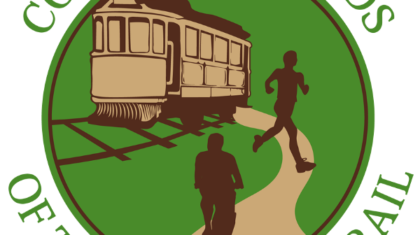
Eight Steps Communities Can Take to Become More Walk and Bike Friendly
Access to reliable, affordable, and efficient transportation is fundamental to the success and happiness of a community, its businesses, residents, and visitors.

Human Life, Health, and Safety are the New Priority
All people deserve to safely walk, bike, take transit, and drive through their communities regardless of their age, race, ability, or background. Making transportation systems safe for vulnerable users makes transportation safe for all users, including vehicular traffic. Just like municipal services, like clean air and water, safe transportation is the government’s responsibility. This must be a top engineering, policy, legislative, and technological priority.

Be Bold.
Strong political will and community organizing may be needed to redesign streets from car-centric thoroughfares to multimodal complete streets. There is a clear correlation between robust, high-functioning bicycle and pedestrian networks and strong leadership from elected officials and agency staff.
Below are eight steps local jurisdictions can take to support walking and biking.

1. Adopt a Complete Streets Policy
A Complete Street policy asserts that all new street projects should accommodate all people who use the street, whether traveling on foot, bike, transit, or car. Cities should identify and recommend land use patterns, parking requirements, and development policies that increase overall mobility, improve and support compact, mixed-use, bikeable and walkable development and connections, and support local economic development.
A policy by itself is ineffective; communities must create an action plan for implementation that meets the vision and goals of the Complete Streets policy.

2. Adopt a Vision Zero Strategy
Vision Zero is a global effort and call to action to reduce fatal crashes to zero. It is the most humanitarian and ethical approach to road safety. Vision Zero began in Sweden and has been implemented with great success; leaders can pull from international best practices through a lens that reflects the limitations and opportunities unique to the political, economic, and social context of their community.
Below are several Vision Zero concepts that can be applied anywhere, regardless of a community’s size or political structure.
Acknowledge That Deaths and Severe Injuries are Preventable
The movement to replace “accident” with “crash” indicates a cultural shift and rejects crashes as chance events with no known cause. The goal of zero fatalities and serious injuries recognizes the ability to influence safe transportation. If we speak the same language when we discuss these efforts, we can build stronger, long term, lasting and effective solutions.
Achieving zero requires major shifts in thinking, planning, prioritizing, and implementation. It requires shared responsibility among planners, engineers, policymakers, law enforcement, emergency responders, public health providers, advocates, and community leaders. Everybody that touches how we plan, design, construct, operate and enforce transportation systems must be at the table.
Prioritize Equity and Engagement
People of color, children, senior citizens, people with disabilities, rural residents, and pedestrian and bicyclists are all disproportionately impacted by crashes. Data can also lead to over-enforcement in areas that have both high crash rates and tension with police. More progressive options include automated enforcement, greater transparency and accuracy of traffic stop data, diversion programs focusing on education not punishment, and tiered fines so low-income people don’t carry a greater burden.
Collective impact is key — integrate equity early and thoroughly and seek creative ways to reach those most affected, controlling for barriers like time, resources, experience, and political access.
Establish Speed Reduction Policies
Traffic speed disproportionately threatens people walking and biking so speed should be managed through speed limit enforcement and traffic calming where appropriate. The foundation of Vision Zero is setting and designing to speed limits that are appropriate for the context and enforcing those speed limits. Education alone is not effective — but it can be, when paired with design and appropriate, data-driven enforcement.
https://blog.altago.com/reducing-speeding-related-crashes-through-design-5d79e8c7af8e
Collect, Analyze, and Use Data to Predict Instead of React
Data is essential to make priorities and decisions about resources and later to evaluate the impact of Vision Zero strategies. Departments of Transportation and police are often responsible for providing traffic safety data, but the data is incomplete and doesn’t always include hospital data and unreported crashes. Many cities are focusing on data coordination. High-level coordination is critical as we often see inconsistent police, Department of Transportation, and hospital data collection, making it very challenging to use. Instead of reacting to crashes that have already occurred, a proactive strategy is to predict crashes before they occur.
Maximize Technological Advances
Technology and Vision Zero quickly jump to autonomous vehicles. Non-motorized modes typically benefit the least from these advances and must be prioritized. While autonomous vehicles bring promise of reducing crashes overall, they do little to improve conditions for people walking and biking. Better bicycle infrastructure design, traffic calming, and lower speed limits have great potential for reducing bicycle and pedestrian injuries and fatalities right now, setting up a “People + Places First” framework for implementing transportation technology.
https://blog.altago.com/reducing-speeding-related-crashes-through-design-5d79e8c7af8e
Low-tech options can also make a big impact. Utility trucks, buses, and freight vehicles are disproportionately responsible for fatal bicyclist and pedestrian crashes in urban areas. Simple treatments like side guards reduce the severity of crashes, as do hands-free-device policies and vehicle-tracking devices for aggressive or reckless driving. The design of emergency response vehicles can be updated to improve maneuvering on narrow streets, allowing for tighter turns, and come equipped with cameras to help look out for conflicts with people walking, biking, and driving. Automated speed enforcement is also proven to discourage speeding.

3. Support Safe and Complete Pedestrian and Bicycle Networks
National standards and best practices for walkway, bikeway and complete streets facility design are evolving quickly as the transportation industry responds to demand for innovation in implementation. These should be incorporated into local standards. Bikeways should form a logical network of facility types that serve transportation and recreation functions and appeal to the full range of users.
https://blog.altago.com/reducing-speeding-related-crashes-through-design-5d79e8c7af8e
The Federal Highway Administration (FHWA) defines complete pedestrian and bicycle transportation networks as “a series of interconnected facilities that allow nonmotorized road users of all ages and abilities to safely and conveniently get where they need to go.”
FHWA has adopted six principles adapted from the Dutch CROW (Centre for Research and Contract Standardization in Civil and Traffic Engineering) manual that provide a useful method and definition for assessing how well a pedestrian and bicycle network meets its intended purpose:
- Cohesion: A connected, cohesive network provides continuous bicycle and pedestrian facilities between destinations
- Directness: A complete network minimizes the distance that pedestrians and bicyclists need to travel to reach destinations
- Accessibility: A complete network accommodates travel for all users, regardless of age or ability
- Alternatives: A complete network provides route choices
- Safety and Security: Policies that promote safety and security are important to minimize the risk of injury, danger, and crime
- Comfort: A complete network appeals to a broad range of age and ability levels with consideration given to user amenities

4. Review Maintenance Plans
Existing facilities such as sidewalks, crosswalks, bike lanes, and trails should be evaluated to determine whether the existing maintenance plan is working, and to make improvements. Just as proper-functioning signage, lighting, and pavements markings are essential to the safety and operations of motor vehicles, so are elements for the safe operation of bicycle and pedestrian facilities. Pavement markings and striping need to remain visible, missing flexible delineators need to be replaced, bike lanes need regular sweeping, and sidewalks need to be repaired.
When facilities are being planned, the department(s) which will be responsible for maintaining the new facilities should be identified, and budget should be allocated to ensure their continued maintenance.
https://blog.altago.com/reducing-speeding-related-crashes-through-design-5d79e8c7af8e
Additionally, creating a connected low-stress bike network reduces maintenance costs, allowing maintenance crews to clear the entire network without needing to travel from one unconnected facility to another.

5. Update Land Use and Development Codes
Local codes that encourage or require short block lengths, mixed use developments with street-fronting retail, and a connected network of streets with high-quality sidewalks form the bedrock of livable communities.
Instead of just meeting code requirements for width and materials, proactive design looks at new aspects such as programming for events, front-end design for effective maintenance, and flexibility over time as technology impacts transportation, governance and infrastructure. Changes in technology are already forcing changes to land use and infrastructure demand.
https://blog.altago.com/reducing-speeding-related-crashes-through-design-5d79e8c7af8e
As walkable, bikeable, and transit-oriented places continue to demonstrate value, curb space will become even more valuable and competitive. Competition for on-street parking, sidewalk and curb space will grow, forcing local managers to allocate, regulate and price rights of way in different ways. Flexible uses will become essential to managing high demand curbsides. In the future, cities will be able to dynamically manage curbside environments in real-time.

6. Rethink Parking Requirements
Parking consumes large amounts of land; cities are introducing new policies related to parking including pricing, parking location and the amount of parking required for new projects. Parking policy reform includes better management of existing parking, pricing that reflects demand, lowering parking requirements for commercial and residential development, and bike parking minimums.
Shared-use and autonomous mobility can reduce car ownership in the future, which in turn changes demand for street capacity and parking. Likewise, autonomous vehicles could free capacity on some streets — where parking spots are replaced by a more space efficient autonomous vehicle pickup zone — making curbside parking obsolete. Cities are already reconsidering the amount of parking needed.

Cities with parking facility proposals under development may need to rethink strategies where parking needs are immediate, but demand over the next 20 years is uncertain. Parking garages and parking lots may be converted to other uses, and parking lots in high-demand locations for public space will likely be redeveloped.

7. Create Safe Walkways and Bikeways Through Construction Zones
Walkways in construction zones should be routed on the same side of the street, run on or parallel to the closed sidewalk, and must comply with the Americans with Disabilities Act and the Manual on Uniform Traffic Control Devices. Cities can ensure safe walkways and bikeways through construction zones by creating policies or guidelines for accessible routes through construction zones.
For example, the City of Seattle created a construction mitigation program called “Access Seattle” to ensure mobility and access through work zones.

8. Use Pilot Projects to Try New Ideas and Solutions
Doing things differently can often be challenging and a step into the unknown for the community and city government. Our teams often work with communities to implement the first of its kind design or policy, including tactical urbanism, demonstration, or quick-build projects that can provide testing for concepts and momentum for longer-term investments.
Interim #tacticalurbanism near downtown Memphis. Construction of 7 intersections is wrapping up now, with 8 more in Phase 2. #eweek2017 pic.twitter.com/xiK1ZoPnrt
— Alta Planning + Design (@altaplanning) February 24, 2017
One of the benefits of demonstration and pilot projects is that they allow for the opportunity to observe road user behavior to the new installation and make adjustments to the design before making it permanent.
Tactical urbanism projects are low cost and have the potential to garner excitement around active transportation. Examples of methods include pavement markings, pop-up bikeways, adding furniture and/or seating to create public space, and using planters as barriers for a protected bike lane.
However, there is more to it than just setting out materials in the road (permitting/approvals, traffic engineering, pre- and post-observations/counts). Communities should plan to measure impacts to traffic and retail sales and solicit ongoing input from the general public to educate people further.
https://www.morgan-hill.ca.gov/DocumentCenter/View/15399
Ready to get started?
Contact us to learn how our team can help you create an active, healthy community. No matter where you are in your journey toward healthy, active lifestyles, we are your partner.


